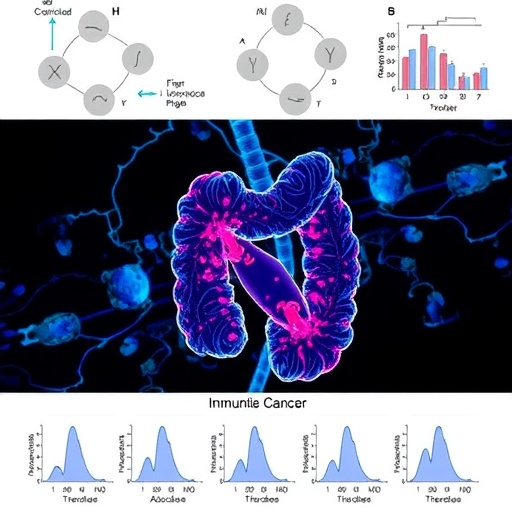In a groundbreaking study poised to transform our understanding of genetic cancer risks, researchers have unveiled new insights into the differential impacts of BRCA1 gene founder variants on contralateral breast cancer (CBC) and ovarian cancer (OC) among affected women. The investigation focused on two specific BRCA1 pathogenic variants (PVs), c.5266dup and c.4035del, tracing their influence on cancer risk following a primary breast cancer (PBC) diagnosis. Their findings represent a significant leap forward in precision oncology, highlighting how subtle genetic differences can lead to starkly distinct cancer trajectories.
This comprehensive retrospective cohort study analyzed 1,364 women carrying these BRCA1 founder variants, contextualizing their risk profiles against a vast control group of 11,350 breast cancer patients without known BRCA1 mutations. By integrating over a decade of follow-up data, the researchers deployed advanced statistical methodologies, including Kaplan-Meier survival analyses and Cox proportional hazards models, to elucidate nuanced risk differentials. The results vividly illustrated that BRCA1 mutation carriers face substantially elevated risks of secondary cancers compared to non-carriers.
One of the most striking findings was the substantial disparity in 10-year cumulative CBC risk between carriers of the two founder variants. Women harboring the c.5266dup mutation exhibited a 25.0% risk of developing contralateral breast cancer within ten years of initial diagnosis—a risk markedly higher than the 13.1% risk observed in c.4035del carriers. In stark contrast, the control population demonstrated only a 3.3% risk, underscoring the profound influence of BRCA1 mutations in shaping breast cancer recurrence. This disparity between c.5266dup and c.4035del underscores the necessity of variant-specific counseling.
Conversely, the OC risk profile displayed an inverse pattern. Women with the c.4035del BRCA1 variant manifested a dramatically heightened 10-year cumulative risk of 22.1% for ovarian cancer, compared to 13.0% among c.5266dup carriers. Both groups far exceeded the control cohort’s baseline OC risk of 1.0%. These differential risks emphasize that not all BRCA1 mutations confer uniform predispositions across cancer types, suggesting variant-specific pathogenic mechanisms at play, potentially involving tissue-specific DNA repair disruptions.
Age at PBC diagnosis emerged as a pivotal factor modulating CBC risk but had negligible impact on OC risk. Specifically, women younger than 40 years at primary breast cancer diagnosis exhibited more than double the risk (hazard ratio of 2.06) of contralateral breast cancer compared to older counterparts. This age effect did not translate to ovarian cancer risk, which remained largely unaffected by age at initial diagnosis. These observations point toward age-dependent biological influences or hormonal environments accelerating breast tissue vulnerability in mutation carriers.
Underlying the differences in CBC and OC risk between the BRCA1 variants could be structural or functional distinctions in the encoded proteins. The c.5266dup mutation, known to truncate BRCA1 protein prematurely, may differentially impair pathways integral to breast epithelial cell genomic stability. Meanwhile, the c.4035del mutation might impact regions of the protein more critical in ovarian tissue tumor suppression. Future molecular dissection will be paramount to validate these hypotheses and uncover mechanistic bases.
Importantly, this differentiation in risk profiles has direct and immediate clinical ramifications. Tailored surveillance strategies can now be devised for BRCA1 carriers based on their specific founder variant. Patients with c.5266dup may benefit from intensified breast cancer monitoring and consideration of contralateral mastectomy, especially if diagnosed before age 40. Conversely, c.4035del carriers might prioritize ovarian cancer risk reduction interventions, such as prophylactic salpingo-oophorectomy, given their pronounced OC predisposition.
The study also highlights the critical necessity of integrating comprehensive genetic testing into standard oncology workflows, reinforcing that a one-size-fits-all approach to BRCA1 mutation carriers may be suboptimal. Precision medicine efforts must factor in not only mutation presence but also particular variant characteristics to refine risk stratification and personalize therapeutic pathways. Such nuance is vital to improving long-term survival outcomes and quality of life.
From a public health perspective, these findings elevate the urgency of identifying founder variant carriers in populations with high BRCA1 mutation prevalence. Genetic counseling programs should incorporate these findings to educate patients about variant-specific risks and available preventive measures, fostering informed decision-making. Furthermore, these data advocate for enhanced genetic literacy among clinicians managing breast and ovarian cancers.
The implications for ongoing BRCA1-related research are profound. By delineating variant-specific phenotypes, this study paves the way for future trials assessing differential responses to targeted therapies such as PARP inhibitors. It also prompts exploration into genotype-driven resistance mechanisms. The molecular heterogeneity illuminated here will undoubtedly shape the future design of clinical trials and therapeutic algorithms.
In summary, the work presents compelling evidence that among BRCA1 mutation carriers, risk trajectories for secondary breast and ovarian cancers diverge strikingly depending on the specific founder variant. The c.5266dup variant confers a predilection for contralateral breast malignancies, markedly exacerbated by younger age at first cancer, while the c.4035del variant predisposes more heavily toward ovarian cancer risk. These insights empower clinicians and patients alike with refined prognostic information, catalyzing a paradigm shift toward more individualized, variant-centered cancer risk management strategies.
As genomic technologies and bioinformatic tools continue to evolve, the nuanced understanding of mutation-specific cancer risks, as illustrated by this research, epitomizes the future of oncogenetics. Personalized medicine thus not only strives for tailored treatments but also revolutionizes preventive care, enabling mutation carriers to navigate their cancer journeys with precise, informed guidance. This pioneering study reaffirms the vital role of precision oncology in saving lives and underscores the complexity underlying hereditary cancer syndromes.
Such revelations emphasize the dynamic and rapidly advancing landscape of cancer genetics. With more data emerging on specific variant effects, healthcare systems must adapt swiftly to translate these discoveries into clinical practice. Collaborative efforts among geneticists, oncologists, and patient advocates will be paramount to ensure that these scientific breakthroughs yield maximal real-world benefits, transforming hereditary cancer management worldwide.
Taken together, this research elevates our comprehension of BRCA1-associated cancer risks to unprecedented granularity. It illustrates vividly how founder variants within a single gene can orchestrate distinct oncogenic outcomes, reinforcing the intricate interplay between genetics and cancer biology. As the scientific community assimilates these findings, the path forward involves integrating variant-specific risk modeling into standard care, enabling earlier interventions and improved survival for women worldwide facing these formidable hereditary cancer risks.
Subject of Research: The study investigates the differing risks of contralateral breast cancer and ovarian cancer in female carriers of two BRCA1 founder gene variants (c.5266dup and c.4035del) following a primary breast cancer diagnosis.
Article Title: The difference in contralateral breast cancer and ovarian cancer risks for BRCA1 founder variant (c.5266dup, c.4035del) carriers with primary breast cancer
Article References: Loza, P., Irmejs, A., Daneberga, Z. et al. The difference in contralateral breast cancer and ovarian cancer risks for BRCA1 founder variant (c.5266dup, c.4035del) carriers with primary breast cancer. BMC Cancer 25, 1769 (2025). https://doi.org/10.1186/s12885-025-15110-y
Image Credits: Scienmag.com
DOI: 14 November 2025
Tags: BRCA1 founder mutations.BRCA1 gene variantsbreast cancer patient cohort studycancer risk profiles comparisoncontralateral breast cancer riskCox proportional hazards modelgenetic cancer risk factorsKaplan-Meier survival analysisovarian cancer riskpathogenic variants analysisprecision oncology advancementssecondary cancer risk in mutation carriers





